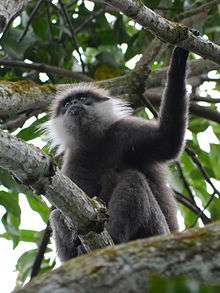Western purple-faced langur
| Western purple-faced langur | |
|---|---|
 | |
| Scientific classification | |
| Kingdom: | Animalia |
| Phylum: | Chordata |
| Class: | Mammalia |
| Order: | Primates |
| Family: | Cercopithecidae |
| Genus: | Semnopithecus |
| Species: | S. vetulus |
| Subspecies: | S. v. nestor |
| Trinomial name | |
| Semnopithecus vetulus nestor (Bennett, 1833) | |
The western purple-faced langur (Semnopithecus vetulus nestor), also known as the north lowland wetzone purple-faced langur, is a subspecies of purple-faced langur endemic to Sri Lanka. It lives in the wet zone in western Sri Lanka around the former capital city of Colombo.[2] The subspecies is generally gray-brown with lighter whiskers, a gray rump patch, and dark forearms and legs.[3] Typical length is between 48 and 67 centimetres (19 and 26 in) excluding tail, with a 59 to 85 centimetres (23 to 33 in) tail.[3] On average, males weigh 8.5 kilograms (19 lb) and females weigh 7.8 kilograms (17 lb).[3]
Since 2004, it has been considered to be critically endangered by the International Union for Conservation of Nature (IUCN) due to an 80% decline in population over the previous 36 years, and the fact that the rate of population decrease is expected to continue unabated.[1] Prior to 2004 it was listed as "endangered", but not "critically endangered".[1] In 2010, the western purple-faced langur was included in the list of The World's 25 Most Endangered Primates, published by the IUCN and other organizations.[4]
Reasons for the subspecies' critical endangerment are largely due to deforestation. Studies have estimated that 81% to over 90% of the subspecies' former range has been deforested. Deforestation harms the monkey in several ways. The western purple-faced langur is naturally folivorous, and its biology is specialized for a diet that consists primarily of leaves. With leaves less available, the monkey's diet consists largely of cultivated fruit taken from people's gardens. This has several detrimental impacts on the monkey - it may not be able to extract adequate nutrition from fruit which it is not biologically adapted to use as a primary food source and the food is only available seasonally, leaving inadequate nutrition outside of fruiting season. Since the western purple-faced langur is naturally arboreal, deforestation also impacts its activities besides eating. With less forest available, monkeys spend more time than is natural on the ground, exposing them to danger from domestic dogs and cars, and they also climb power lines, exposing them to danger of electrocution. Also, when the monkeys are on the ground, they are easier to capture for the pet trade.[4] Hunting is also a concern.[1]
Hope for the subspecies continued survival comes from the fact that the largest forests that it currently inhabits are around important water reservoirs and thus less likely to be exploited for other purposes.[4][5] Also the Sri Lanka Forest Department is undertaking a project to promote forest conservation.[4]
References
- 1 2 3 4 Dittus, W.; Molur, S. & Nekaris, A. (2008). "Trachypithecus vetulus ssp. nestor". IUCN Red List of Threatened Species. Version 2008. International Union for Conservation of Nature. Retrieved 5 August 2010.
- ↑ Dela, J. & Rowe, N. "Western Purple-Faced Langur". Retrieved 2010-08-05.
- 1 2 3 "Purple-faced Langur (Trachypithecus vetulus)". Retrieved 2010-08-05.
- 1 2 3 4 Mittermeier, R.A.; Wallis, J.; Rylands, A.B.; Ganzhorn, J.U.; Oates, J.F.; Williamson, E.A.; Palacios, E.; Heymann, E.W.; Kierulff, M.C.M.; Long Yongcheng; Supriatna, J.; Roos, C.; Walker, S.; Cortés-Ortiz, L.; Schwitzer, C., eds. (2009). "Primates in Peril: The World's 25 Most Endangered Primates 2008–2010" (PDF). Illustrated by S.D. Nash. Arlington, VA.: IUCN/SSC Primate Specialist Group (PSG), International Primatological Society (IPS), and Conservation International (CI): 1–92. ISBN 978-1-934151-34-1.
- ↑ Rudran, R. (2007). "A Survey of Sri Lanka's Endangered and Endemic Western Purple-faced Langur (Trachypithecus vetulus nestor)" (PDF). Primate Conservation. 22: 139–144. doi:10.1896/052.022.0115.
